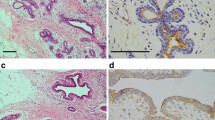Abstract
Glutathione peroxidase 3 (GPX3) is a member of glutathione peroxidase family, exerting one of the most important cellular defense mechanisms against stress signals, including oxidative damage. In this study, the expression of GPX3 mRNA and protein was analyzed for ovarian cancer tissues to test its applicability as a biomarker that can distinguish the four major histologic types of epithelial ovarian cancer. A public microarray dataset containing 99 ovarian cancer and 4 normal ovary samples was downloaded, and GPX3 mRNA expression was analyzed. The expression of GPX3 protein was measured by immunohistochemical staining in 40 epithelial ovarian cancer tissues, 10 for each of the serous, endometrioid, mucinous, and clear cell type. Histoscores were made from the immunohistostaining, and analysis of variance (ANOVA) was performed to quantitate the differences in protein level. Analysis of genomic dataset confirms a GPX3 overexpression in clear cell type ovarian adenocarcinoma compared with normal ovary and 3 other subtypes of epithelial ovarian cancer at mRNA level. GPX3 also shows the highest average antibody staining intensities in clear cell type ovarian adenocarcinomas over the other 3 types in immunostaining on tissue arrays. This is the first validation of GPX3 as a clear cell type–specific biomarker in ovarian cancer patients’ tissues by immunostaining. GPX3 may serve as an important molecular marker for the diagnosis and molecular understanding of clear cell carcinoma of the ovary.



Similar content being viewed by others
References
Brigelius-Flohé R. Glutathione peroxidases and redox-regulated transcription factors. Biol Chem. 2006;387:1329–35.
Beckett GJ, Arthur JR. Selenium and endocrine systems. J Endocrinol. 2005;184:455–65.
Comhair SA, Erzurum SC. The regulation and role of extracellular glutathione peroxidase. Antioxid Redox Signal. 2005;7:72–9.
Lee O-J, Schneider-Stockz R, McChesney PA, et al. Hypermethylation and loss of expression of glutathione peroxidase-3 in barrett’s tumorigenesis. Neoplasia. 2005;7:854–61.
Yu YP, Yu G, Tseng G, et al. Glutathione peroxidase 3, deleted or methylated in prostate cancer, suppresses prostate cancer growth and metastasis. Cancer Res. 2007;67:8043–50.
Parkin DM, Bray F, Ferlay J, et al. Global cancer statistics, 2002. CA Cancer J Clin. 2005;55:74–108.
Olivier RI, van Beurden M, van’ t Veer LJ. The role of gene expression profiling in the clinical management of ovarian cancer. Eur J Cancer. 2006;42:2930–8.
Mok SC, Elias KM, Wong KK, et al. Biomarker discovery in epithelial ovarian cancer by genomic approaches. Adv Cancer Res. 2007;96:1–22.
Farley J, Ozbun LL, Birrer MJ. Genomic analysis of epithelial ovarian cancer. Cell Res. 2008;18:538–48.
Sugiyama T, Kamura T, Kigawa J, et al. Clinical characteristics of clear cell carcinoma of the ovary. Cancer. 2000;88:2584–9.
Schwartz DR, Kardia SLR, Shedden KA, et al. Gene expression in ovarian cancer reflects both morphology and biological behavior, distinguishing clear cell from other poor-prognosis ovarian carcinomas. Cancer Res. 2002;62:4722–9.
Hough C, Cho K, Zonderman A, et al. Coordinately up-regulated genes in ovarian cancer. Cancer Res. 2001;61:3869–76.
Saga Y, Ohwada M, Suzuki M, et al. Glutathione peroxidase 3 is a candidate mechanism of anticancer drug resistance of ovarian clear cell adenocarcinoma. Oncol Rep. 2008;20:1299–303.
Witton C, Hawe S, Cooke T, et al. Cyclooxygenase 2 (COX2) expression is associated with poor outcome in ER-negative, but not ER-positive, breast cancer. Histopathology. 2004;45:47–54.
Cannistra SA. Cancer of the ovary. N Engl J Med. 2004;351:2519–29.
Itamochi H, Kigawa J, Terakawa N. Mechanisms of chemoresistance and poor prognosis in ovarian clear cell carcinoma. Cancer Sci. 2008;99:653–8.
Peng D, Razvi MH, Chen H, et al. DNA hypermethylation regulates the expression of members of the Mu-class glutathione S-transferases and glutathione peroxidases in barrett’s-related adenocarcinomas. Gut. 2009;58(1):5–15.
Dobosy JR, Roberts JLW, Fu VX, et al. The expanding role of epigenetics in the development, diagnosis and treatment of prostate cancer and benign prostatic hyperplasia. J Urol. 2007;177:822–31.
Yang S, Chung H. Novel biomarker candidates for gastric cancer. Oncol Rep. 2008;19:675–80.
Shimizu M, Nikaido T, Toki T, et al. Clear cell carcinoma has an expression pattern of cell cycle regulatory molecules that is unique among ovarian adenocarcinomas. Cancer. 1999;85:669–77.
Acknowledgments
This study was supported by a grant from the National R&D Program for Cancer Control, Ministry for Health, Welfare and Family affairs, Republic of Korea (0820330).
Author information
Authors and Affiliations
Corresponding author
Rights and permissions
About this article
Cite this article
Lee, H.J., Do, J.H., Bae, S. et al. Immunohistochemical evidence for the over-expression of Glutathione peroxidase 3 in clear cell type ovarian adenocarcinoma. Med Oncol 28 (Suppl 1), 522–527 (2011). https://doi.org/10.1007/s12032-010-9659-0
Received:
Accepted:
Published:
Issue Date:
DOI: https://doi.org/10.1007/s12032-010-9659-0




